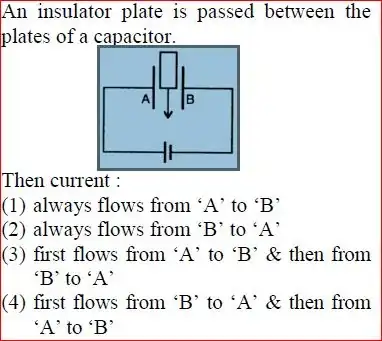Insertion of a dielectric does not directly affect the charge on the plates (unless you insert it slowly); rather, it decreases the electric field between the plates. As the electric field and the potential are related by $V = Ed$, the potential difference across the capacitor also decreases ($d$ remains constant; $E$ decreases, therefore $V$ decreases).
Case 1: Capacitor is fully charged before insertion
Initially, the potential difference across the capacitor would be equal to the E.M.F of the battery. As the insertion of dielectric reduces the potential difference across the capacitor, a current is driving in the circuit such that the potential drop across the capacitor equals the E.M.F. If the potential drop across the capacitor has to increase, the charge on the plates must increase; therefore, the current flows in the direction which increases charge on the capacitor. This direction is from $A$ to $B$.
Case 2: Capacitor is not fully charged; on its way to being fully charged
Initially, the potential difference across the capacitor is less than the E.M.F of the battery. When the dielectric is inserted, the potential difference drops. For the reasons mentioned in the previous case, the current will flow in such a way that the charge on the capacitor increases. This direction is from $A$ to $B$.
Case 3: Capacitor is overcharged; potential drop across the capacitor is more than the E.M.F
Initially, the potential difference across the capacitor is more than the E.M.F. This would cause the current to charge the battery (initial current is from $B$ to $A$). After the dielectric is inserted, the potential drop across the capacitor decreases. There are two sub-cases in this situation.
The new potential drop is smaller than the E.M.F
The current reverses. The current flows such that the potential drop across the capacitor increases (tries to fully charge the capacitor). The direction of current is from $A$ to $B$.
The new potential drop is greater than the E.M.F
As the potential drop across the capacitor is greater than the E.M.F, the current continues to flow from $B$ to $A$.
